Abstract
All 607 men, aged 17 to 69, comprising a stratified sample of workers from one shipyard completed a respiratory questionnaire, clinical examination, and detailed spirometry. Chest radiographs were available on 332 men. Among the men aged 50-69 the prevalence of persistent cough and phlegm (chronic bronchitis) was 40%, of wheeze on most days 25%, and undue breathlessness on exertion 25%. After allowing for age the relative risk of welders and caulker/burners having these symptoms were respectively 2.8, 2.2, and 3.1 compared with other shipyard tradesmen. The effects were of comparable magnitude to and interacted with those of current smoking. Among the welders and caulker/burners who smoked, the relative risk of developing chronic bronchitis or undue breathlessness was related to the average fume exposure; the relative risk of wheeze was related to the average fume exposure in all smoking categories, with the strongest association in the ex-smokers. The occurrence of wheeze was also associated with a history of previous metal fume fever. A history of pleurisy but not of pneumonia was related to the fume exposure in the welders. After allowing for age and stature, forced expiratory volume (FEV1) was on average higher in young welders (age less than 30) than other tradesmen. In welders and caulker/burners who were current or ex-smokers, FEV1 and PEF were reduced in relation to the average fume exposure (mean reductions respectively 0.25 l and 0.99 l s-1). The FEV1% (of forced vital capacity), the flow rates at small lung volumes (MEF50%FVC and MEF25%FVC), the mean transit time, and its standard deviation were also reduced by fume exposure or the declines with age were increased, or both. No impairment was demonstrable in the non-smokers and many men had given up smoking with apparently beneficial results. The occupational component of the respiratory impairment related mainly to exposures in the past; information was needed on the effects of present conditions in the industry.
Full text
PDF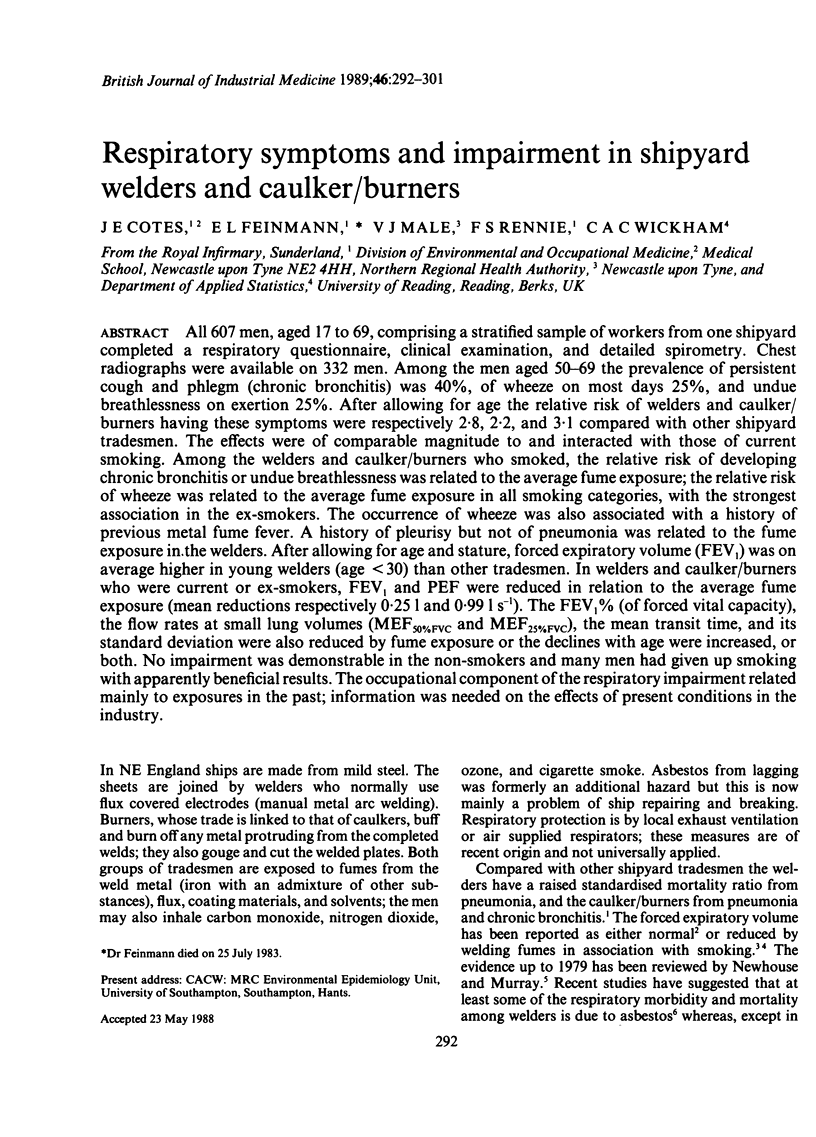
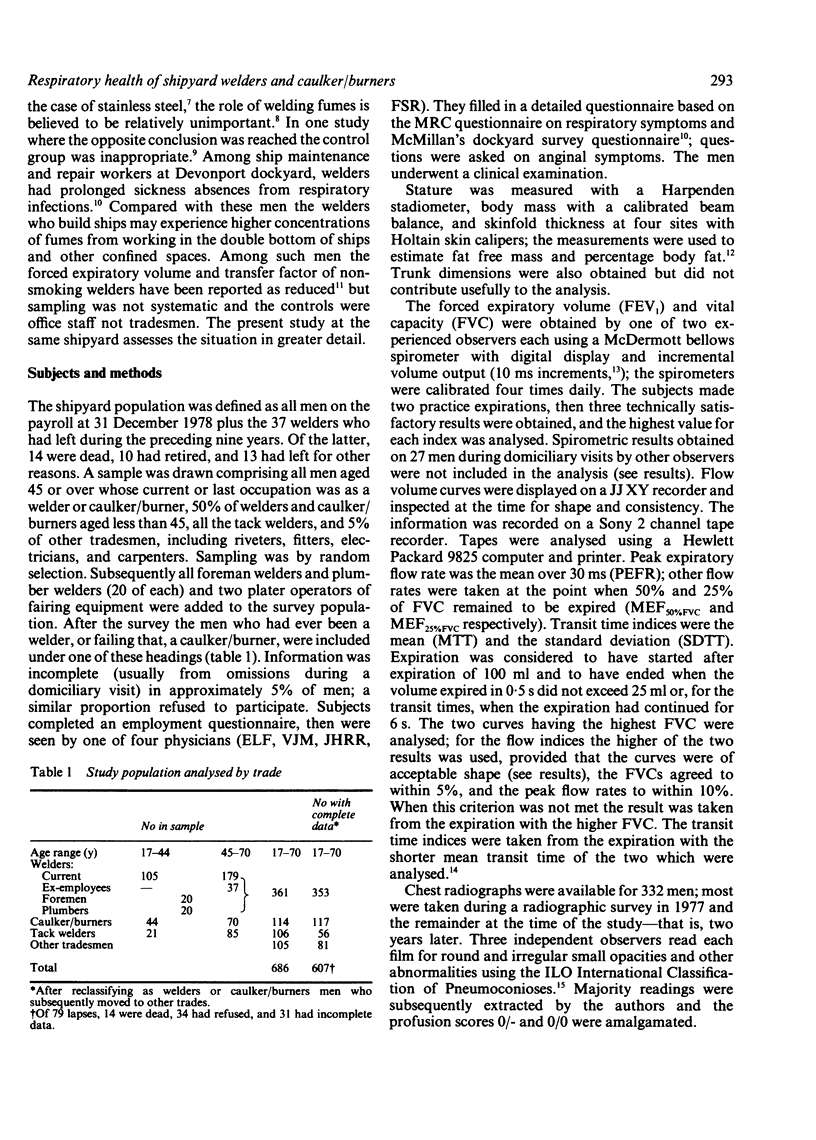
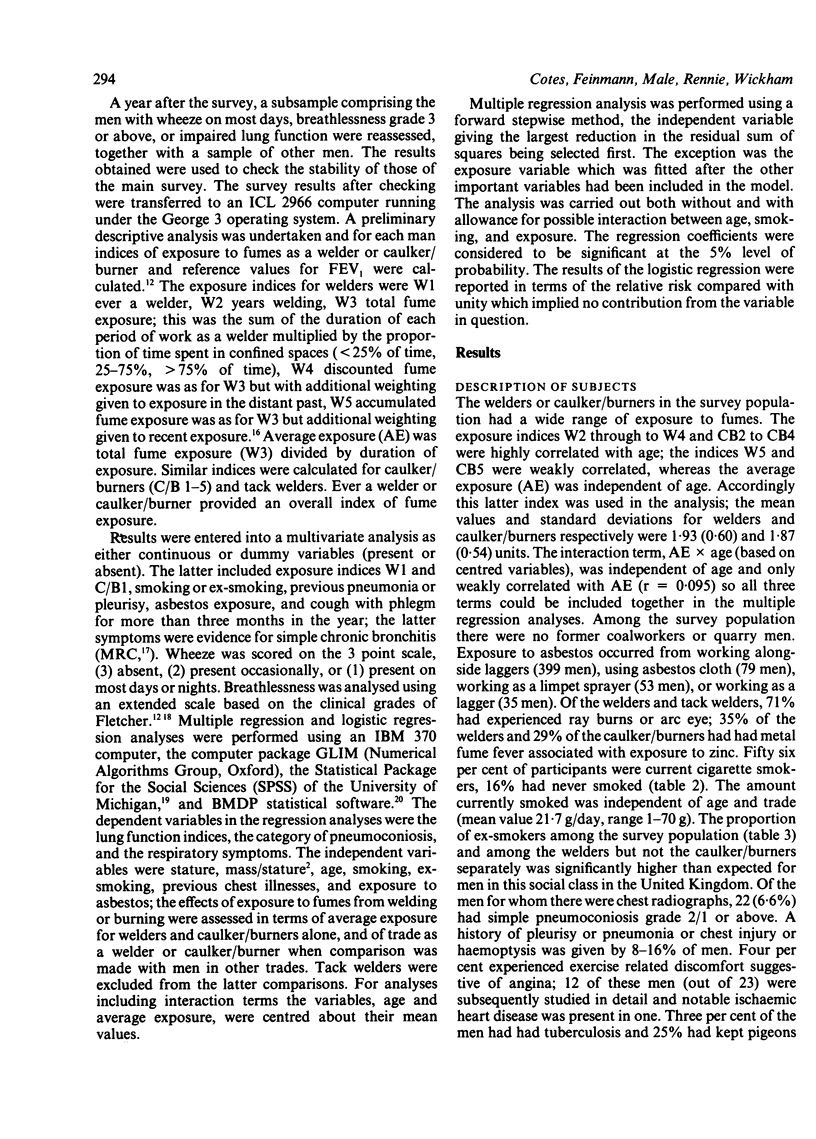


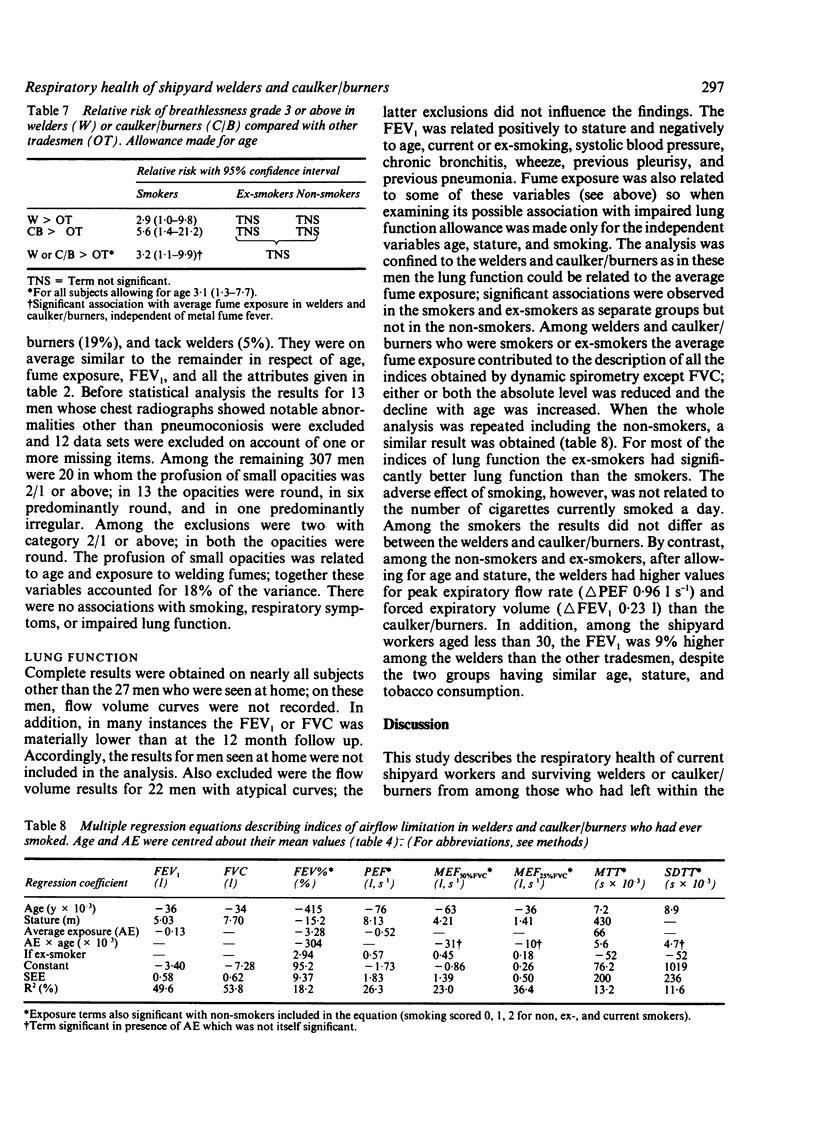
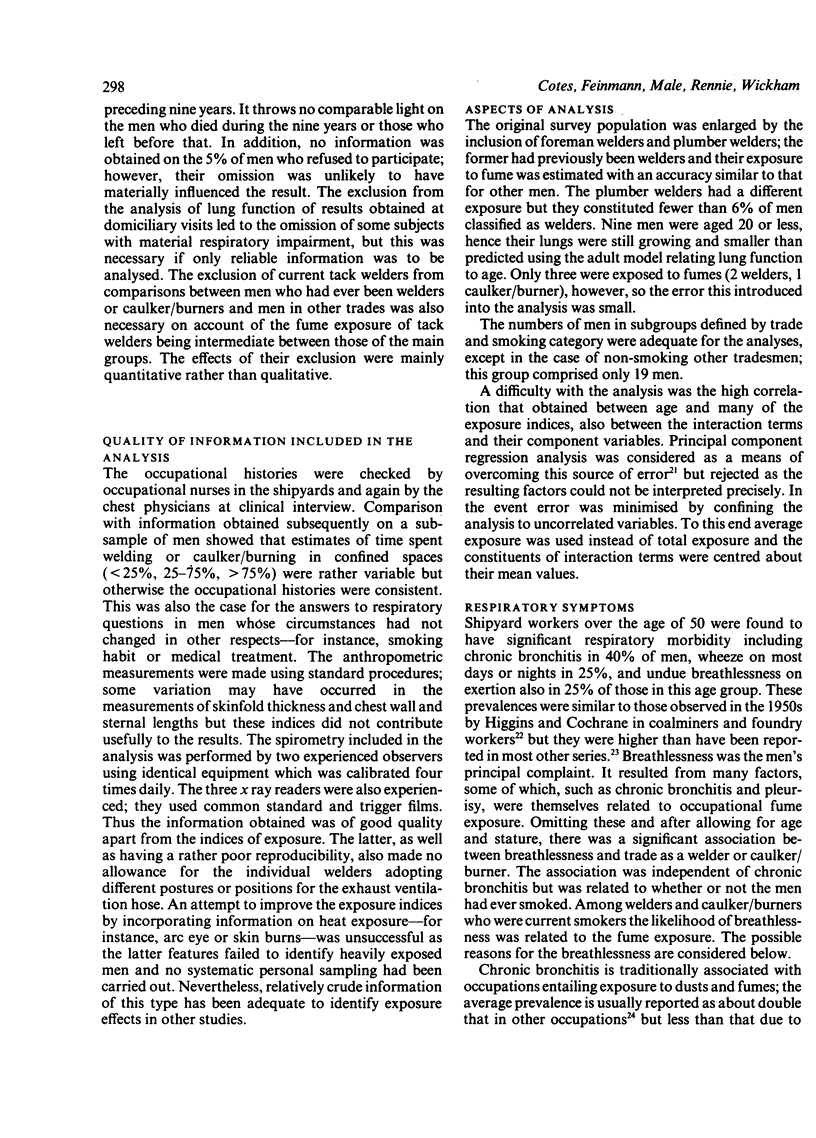

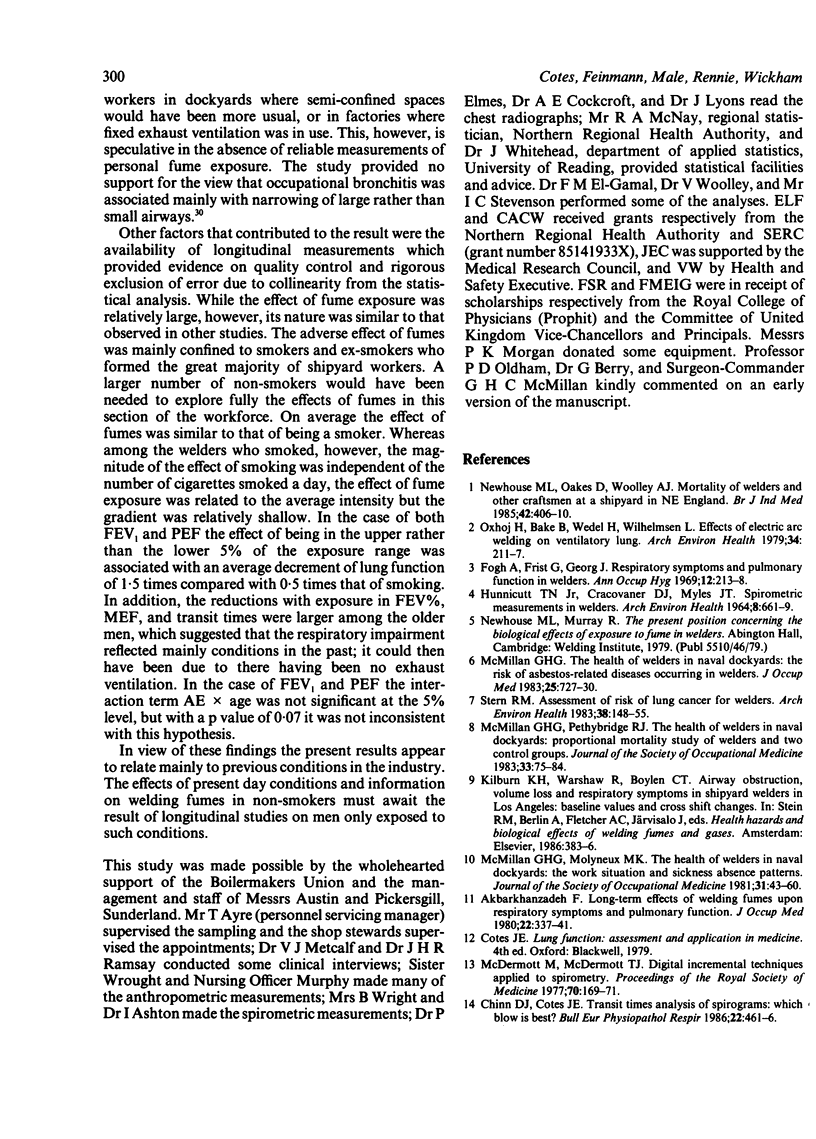

Selected References
These references are in PubMed. This may not be the complete list of references from this article.
- Akbarkhanzadeh F. Long-term effects of welding fumes upon respiratory symptoms and pulmonary function. J Occup Med. 1980 May;22(5):337–341. doi: 10.1097/00043764-198005000-00007. [DOI] [PubMed] [Google Scholar]
- Barhad B., Pilat L., Teculescu D. Recent progress in the study of occupational lung diseases in Romania. Br J Ind Med. 1975 May;32(2):164–168. doi: 10.1136/oem.32.2.164. [DOI] [PMC free article] [PubMed] [Google Scholar]
- Chinn D. J., Cotes J. E. Transit time analysis of spirograms: which blow is best? Bull Eur Physiopathol Respir. 1986 Sep-Oct;22(5):461–466. [PubMed] [Google Scholar]
- Cotes J. E., Zejda J., King B. Lung function impairment as a guide to exercise limitation in work-related lung disorders. Am Rev Respir Dis. 1988 May;137(5):1089–1093. doi: 10.1164/ajrccm/137.5.1089. [DOI] [PubMed] [Google Scholar]
- Darlington R. B. Multiple regression in psychological research and practice. Psychol Bull. 1968 Mar;69(3):161–182. doi: 10.1037/h0025471. [DOI] [PubMed] [Google Scholar]
- FLETCHER C. M. The clinical diagnosis of pulmonary emphysema; an experimental study. Proc R Soc Med. 1952 Sep;45(9):577–584. [PubMed] [Google Scholar]
- Fawer R. F., Gardner A. W., Oakes D. Absences attributed to respiratory diseases in welders. Br J Ind Med. 1982 May;39(2):149–152. doi: 10.1136/oem.39.2.149. [DOI] [PMC free article] [PubMed] [Google Scholar]
- Fogh A., Frost J., Georg J. Respiratory symptoms and pulmonary function in welders. Ann Occup Hyg. 1969 Oct;12(4):213–218. doi: 10.1093/annhyg/12.4.213. [DOI] [PubMed] [Google Scholar]
- Gilson J. C. Occupational bronchitis? Proc R Soc Med. 1970 Sep;63(9):857–864. [PMC free article] [PubMed] [Google Scholar]
- HIGGINS I. T., COCHRANE A. L. Chronic respiratory disease in a random sample of men and women in the Rhondda Fach in 1958. Br J Ind Med. 1961 Apr;18:93–102. doi: 10.1136/oem.18.2.93. [DOI] [PMC free article] [PubMed] [Google Scholar]
- HUNNICUTT T. N., Jr, CRACOVANER D. J., MYLES J. T. SPIROMETRIC MEASUREMENTS IN WELDERS. Arch Environ Health. 1964 May;8:661–669. doi: 10.1080/00039896.1964.10663737. [DOI] [PubMed] [Google Scholar]
- McDermott M., McDermott T. J. Digital incremental techniques applied to spirometry. Proc R Soc Med. 1977 Mar;70(3):169–171. [PMC free article] [PubMed] [Google Scholar]
- McMillan G. H., Molyneux M. K. The health of welders in naval dockyards: the work situation and sickness absence patterns. J Soc Occup Med. 1981 Apr;31(2):43–60. doi: 10.1093/occmed/31.2.43. [DOI] [PubMed] [Google Scholar]
- McMillan G. H., Pethybridge R. J. The health of welders in naval dockyards: proportional mortality study of welders and two control groups. J Soc Occup Med. 1983 Apr;33(2):75–84. doi: 10.1093/occmed/33.2.75. [DOI] [PubMed] [Google Scholar]
- McMillan G. H. The health of welders in naval dockyards. The risk of asbestos-related diseases occurring in welders. J Occup Med. 1983 Oct;25(10):727–730. doi: 10.1097/00043764-198310000-00011. [DOI] [PubMed] [Google Scholar]
- Morgan W. K. Industrial bronchitis. Br J Ind Med. 1978 Nov;35(4):285–291. doi: 10.1136/oem.35.4.285. [DOI] [PMC free article] [PubMed] [Google Scholar]
- Mosinger M., Charpin J., Rouyer P., Luccioni R., Dantin F., Dantin B. Sur les sidéroses, sidéro-scléroses et sidérosilicoses. A propos du tableau no 44. Arch Mal Prof. 1968 Jan-Feb;29(1):59–66. [PubMed] [Google Scholar]
- Musk A. W., Cotes J. E., Bevan C., Campbell M. J. Relationship between type of simple coalworkers' pneumoconiosis and lung function. A nine-year follow-up study of subjects with small rounded opacities. Br J Ind Med. 1981 Nov;38(4):313–320. doi: 10.1136/oem.38.4.313. [DOI] [PMC free article] [PubMed] [Google Scholar]
- Newhouse M. L., Oakes D., Woolley A. J. Mortality of welders and other craftsmen at a shipyard in NE England. Br J Ind Med. 1985 Jun;42(6):406–410. doi: 10.1136/oem.42.6.406. [DOI] [PMC free article] [PubMed] [Google Scholar]
- Oxhoj H., Bake B., Wedel H., Wilhelmsen L. Effects of electric arc welding on ventilatory lung function. Arch Environ Health. 1979 Jul-Aug;34(4):211–217. doi: 10.1080/00039896.1979.10667400. [DOI] [PubMed] [Google Scholar]
- Soter N. A., Wasserman S. I., Austen K. F. Cold urticaria: release into the circulation of histamine and eosinophil chemotactic factor of anaphylaxis during cold challenge. N Engl J Med. 1976 Mar 25;294(13):687–690. doi: 10.1056/NEJM197603252941302. [DOI] [PubMed] [Google Scholar]
- Stern R. M. Assessment of risk of lung cancer for welders. Arch Environ Health. 1983 May-Jun;38(3):148–155. doi: 10.1080/00039896.1983.10543996. [DOI] [PubMed] [Google Scholar]


